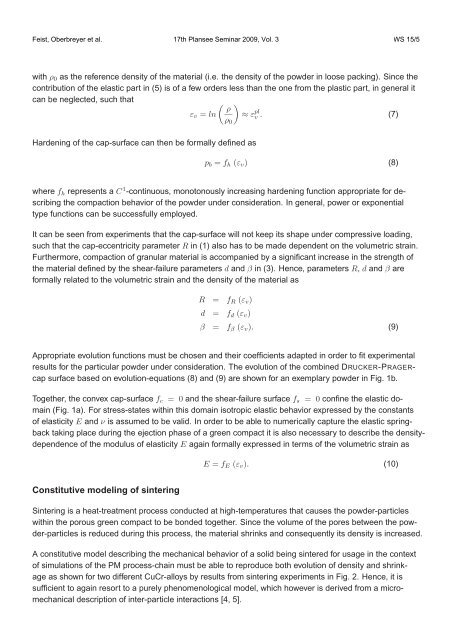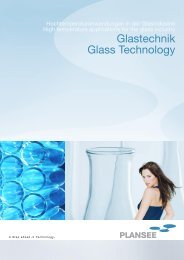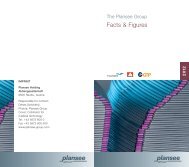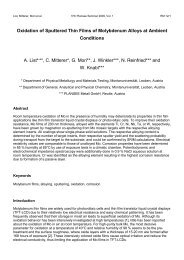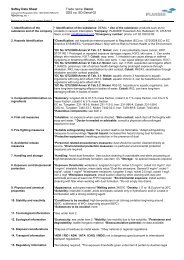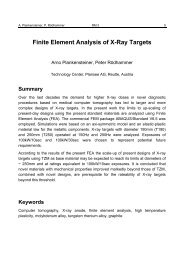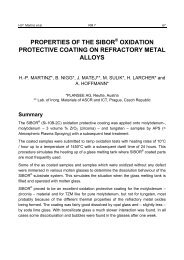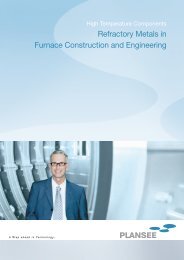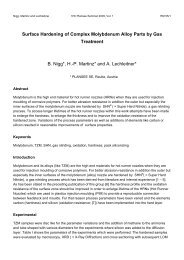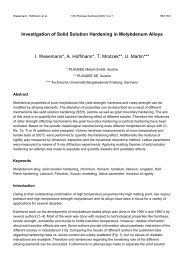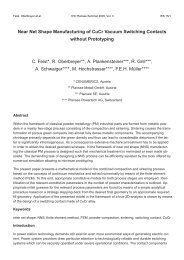Near Net Shape Manufacturing of CuCr Vacuum Switching Contacts ...
Near Net Shape Manufacturing of CuCr Vacuum Switching Contacts ...
Near Net Shape Manufacturing of CuCr Vacuum Switching Contacts ...
Create successful ePaper yourself
Turn your PDF publications into a flip-book with our unique Google optimized e-Paper software.
Feist, Oberbreyer et al. 17th Plansee Seminar 2009, Vol. 3 WS 15/5<br />
with ρ0 as the reference density <strong>of</strong> the material (i.e. the density <strong>of</strong> the powder in loose packing). Since the<br />
contribution <strong>of</strong> the elastic part in (5) is <strong>of</strong> a few orders less than the one from the plastic part, in general it<br />
can be neglected, such that<br />
Hardening <strong>of</strong> the cap-surface can then be formally defined as<br />
� �<br />
ρ<br />
εv = ln ≈ ε<br />
ρ0<br />
pl<br />
v . (7)<br />
pb = fh (εv) (8)<br />
where fh represents a C 1 -continuous, monotonously increasing hardening function appropriate for describing<br />
the compaction behavior <strong>of</strong> the powder under consideration. In general, power or exponential<br />
type functions can be successfully employed.<br />
It can be seen from experiments that the cap-surface will not keep its shape under compressive loading,<br />
such that the cap-eccentricity parameter R in (1) also has to be made dependent on the volumetric strain.<br />
Furthermore, compaction <strong>of</strong> granular material is accompanied by a significant increase in the strength <strong>of</strong><br />
the material defined by the shear-failure parameters d and β in (3). Hence, parameters R, d and β are<br />
formally related to the volumetric strain and the density <strong>of</strong> the material as<br />
R = fR (εv)<br />
d = fd (εv)<br />
β = fβ (εv). (9)<br />
Appropriate evolution functions must be chosen and their coefficients adapted in order to fit experimental<br />
results for the particular powder under consideration. The evolution <strong>of</strong> the combined DRUCKER-PRAGERcap<br />
surface based on evolution-equations (8) and (9) are shown for an exemplary powder in Fig. 1b.<br />
Together, the convex cap-surface fc = 0 and the shear-failure surface fs = 0 confine the elastic domain<br />
(Fig. 1a). For stress-states within this domain isotropic elastic behavior expressed by the constants<br />
<strong>of</strong> elasticity E and ν is assumed to be valid. In order to be able to numerically capture the elastic springback<br />
taking place during the ejection phase <strong>of</strong> a green compact it is also necessary to describe the densitydependence<br />
<strong>of</strong> the modulus <strong>of</strong> elasticity E again formally expressed in terms <strong>of</strong> the volumetric strain as<br />
Constitutive modeling <strong>of</strong> sintering<br />
E = fE (εv). (10)<br />
Sintering is a heat-treatment process conducted at high-temperatures that causes the powder-particles<br />
within the porous green compact to be bonded together. Since the volume <strong>of</strong> the pores between the powder-particles<br />
is reduced during this process, the material shrinks and consequently its density is increased.<br />
A constitutive model describing the mechanical behavior <strong>of</strong> a solid being sintered for usage in the context<br />
<strong>of</strong> simulations <strong>of</strong> the PM process-chain must be able to reproduce both evolution <strong>of</strong> density and shrinkage<br />
as shown for two different <strong>CuCr</strong>-alloys by results from sintering experiments in Fig. 2. Hence, it is<br />
sufficient to again resort to a purely phenomenological model, which however is derived from a micromechanical<br />
description <strong>of</strong> inter-particle interactions [4, 5].


